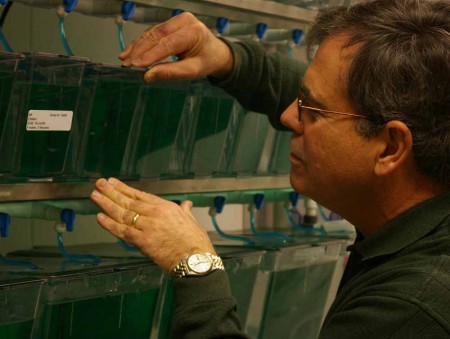
They are interested in the study of melanoma, a malignant tumor associated with skin cancer, and how stem cells relate to that research and could prove to be the key.
Hoerter, a FSU biology professor, declined to be interviewed for this article, preferring the focus to be on the students and the research they are involved in.
Patrick Bradley, an FSU student from Fremont, is the laboratory manager for the research project. Bradley has a B.S. in Pre-Medicine Biology and is currently working towards his degree in Biotechnology.
Research can be daunting, but Bradley says he enjoys the interaction with others in the scientific community.
“What I most enjoy about the research is the cooperation that we receive in the lab and from other researchers around the country and the world,” Bradley said.
According to Bradley, he “keeps track of all of the experiments that are going on in the lab and helps new people get started with the research.”
Zebrafish, a striped tropical fish about the size of the pinky finger, are studied in this experiment becuase their stem cells are almost identical to humans.
“Zebrafish research is relatively new and many of the researchers maintain an excited attitude that makes the work fun,” Bradley said.
Why zebrafish?
For one they are inexpensive to care for and despite their distance on the evolutionary tree from humans, we share many similarities.
“Zebrafish have many similarities to humans in how they develop melanoma. Many of the genes are similar to ours and that makes them a very good model to use,” Bradley said.
Since zebrafish are so identical to humans in their stem cells, it is possiable to determine what affects the sun has on humans by observing the affects the sun (ultraviolet light) has on the zebrafish in the experiment.
In order to see the damage melanoma is doing to the Zebra fish at the genetic level, the researches use ultraviolet light.
This light is the same light that an average person would get at a day at the beach. The researchers carefully measure how much light the fish receive.
“Zebrafish can regenerate many of their structures…they use stem cells that are positioned throughout their bodies to fully regenerate their tail fins in a couple of weeks,” Bradley said.
Bradley went on to say, “We can link abnormal development to UV radiation that they received earlier and that information strengthens the case for the importance of stem cells in the development of disease and melanoma in particular.”
Zebrafish can regenerate more than just their tail.
“They can also regenerate cardiomyocytes (heart muscle cells), repair extensive nerve damage, and regenerate tissues in their eyes,” Bradley said.
It should be noted that no zebrafish are harmed in any of the experiments done at FSU.
The National Institute of Health just provided a grant to Ferris for the research on melanoma. Bradley said the grant would most likely be used on equipment, chemical supplies, fish and habitat areas for the fish to live in.
This project has been going on for more than two years and the efforts of those involved have not gone unrewarded.
“We have found some preliminary results and are constantly adding data to our collection. Repeated trials are always needed in this kind of research and whenever possible publication is involved. The results must be verified and we use a lot of statistics,” Bradley said.
The project first began at FSU when Hoerter became interested in the research while on a trip in Ireland. He then started laying the groundwork for the research and project at FSU.
Hoerter was awarded the Ferris Foundation for Excellence Merit Grant in 2009. He then purchased a zebrafish habitat in order to begin the research project.
According to the College of Arts and Sciences website, Hoerter sees the research lab to be an extention of the classroom.
“A research lab is one of the most effective ways to teach students to think as a scientist, to experiment, analyze and evaluate data, and then communicate and defend the significance of the results to the scientific communit,” the website says.
The research is not strickly limited to those in Hoerter’s classroom or those in a specific field of study.
“I got involved in the research by originally coming to the weekly meetings and listening to what was happening in the lab.
“I advise others who want to follow what is happening with the research, and possibly want to get involved, to stop into the lab and talk to someone or attend the weekly meeting,” Bradley said.
For more information on weekly meetings, email Bradley at pa*************@*****il.com.
